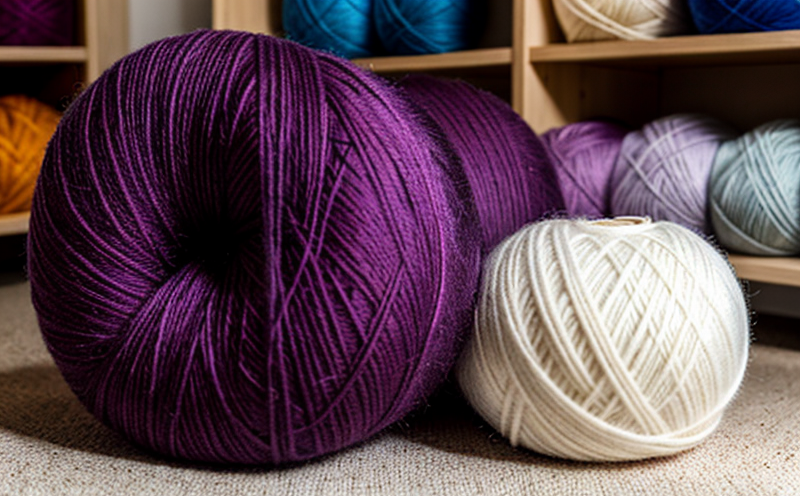UNE EN ISO 2062 Ensayo de Resistencia a la Tracción de Hilos
The UNE EN ISO 2062 test method is designed to determine the tensile strength and elongation at break of yarns. This testing procedure provides essential data for quality control, R&D, and compliance officers within the textile industry. The standard ensures that manufacturers can produce consistent products by validating the mechanical properties of their yarns.
UNE EN ISO 2062 is applicable to a wide range of textile fibers such as cotton, polyester, rayon, and blends. It specifies the procedures for preparing specimens, conducting the test, and interpreting results. The method involves placing a specimen between two grips on a testing machine, applying tension until it breaks, and recording the maximum force applied before failure.
The standard is critical in ensuring that yarns meet specified performance criteria. Compliance with UNE EN ISO 2062 helps manufacturers maintain consistent quality standards, which are essential for customer satisfaction and competitive advantage. The test results are also crucial inputs for R&D teams to optimize the properties of new yarns.
UNE EN ISO 2062 is often used in conjunction with other textile testing methods like UNE EN ISO 14972 (Dyeing) or UNE EN ISO 13935-1 (Flammability). These combined tests provide a comprehensive understanding of the yarn's overall performance. The tensile strength and elongation at break are vital parameters for predicting the durability, flexibility, and wear resistance of textile products.
The testing machine used in UNE EN ISO 2062 should be capable of applying tension with high precision. Specimens must be prepared according to the standard's specifications, including cutting them into specific lengths and widths. The specimens are then clamped between the grips of the tensile tester, which applies a controlled rate of force until they break.
| Parameter | Description |
|---|---|
| Tensile Strength | The maximum force applied to the specimen before it breaks. |
| Elongation at Break | The amount of extension or elongation that occurs in the yarn as it is being pulled until it breaks. |
The results of UNE EN ISO 2062 tests are typically reported in units of Newtons per square millimeter (N/mm²) for tensile strength and percentage (%) for elongation. These values provide a clear indication of the yarn's mechanical properties, which can be used to optimize production processes or improve product design.
Quality managers rely on UNE EN ISO 2062 results to ensure that their products meet industry standards and customer expectations. Compliance officers use these tests to verify that their suppliers are adhering to quality control protocols. R&D engineers leverage the data from this test to innovate new yarns with enhanced performance characteristics.
Benefits
Implementing UNE EN ISO 2062 testing offers several benefits:
Improved Product Quality: By ensuring that yarns meet the specified tensile strength and elongation criteria, manufacturers can produce higher quality products.
Increased Efficiency: Consistent testing results help streamline production processes, reducing waste and increasing efficiency.
Better Decision Making: The data from UNE EN ISO 2062 tests provides valuable insights into the mechanical properties of yarns, enabling informed decisions about raw materials and production methods.
Enhanced Customer Satisfaction: Ensuring that products meet or exceed industry standards can lead to higher customer satisfaction and loyalty.
Competitive Advantage: Consistent quality control through testing ensures that a company remains competitive in the market.
The ability to produce high-quality yarns consistently is crucial for maintaining brand reputation. By adhering to UNE EN ISO 2062, companies can demonstrate their commitment to excellence and reliability, which are key factors in building trust with customers and stakeholders.
Industry Applications
The UNE EN ISO 2062 test method finds applications across various sectors within the textile industry:
| Sector | Description |
|---|---|
| Clothing Manufacturing | Ensuring that clothing materials are durable and flexible. |
| Furniture Manufacturing | Verifying the strength of textile components used in furniture construction. |
| Hospitality | Evaluating textiles used in hotel linens for durability and comfort. |
| Sports Apparel | Promoting the development of high-performance sports fabrics with enhanced strength and flexibility. |
Each sector has unique requirements regarding the mechanical properties of yarns, making UNE EN ISO 2062 an indispensable tool for ensuring that textiles meet these needs. The test method is particularly important in sectors where durability and performance are critical, such as sports apparel or furniture manufacturing.
Use Cases and Application Examples
The application of UNE EN ISO 2062 extends beyond the laboratory into real-world scenarios:
| Application Example | Description |
|---|---|
| Sportswear Manufacturing | Determining the tensile strength of high-performance fibers used in sports apparels. |
| Furniture Design and Development | Testing the durability of upholstery fabrics for furniture pieces. |
| Hospital Linen Quality Control | Ensuring that hospital linens maintain their structural integrity over time. |
| Clothing Line Development | Evaluating the flexibility and strength of new fabric designs. |
In each case, UNE EN ISO 2062 provides critical information about the mechanical properties of yarns. This data is used by manufacturers to make informed decisions that improve product quality and performance. For instance, in sports apparel manufacturing, high tensile strength is essential for ensuring that the fabric can withstand rigorous use during workouts.
The test results also help in optimizing production processes. By identifying weak points in the yarn's structure, manufacturers can adjust their production methods to enhance overall quality. This approach not only improves product performance but also reduces waste and increases efficiency.





